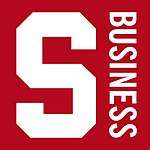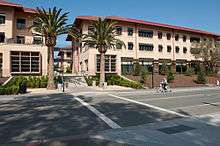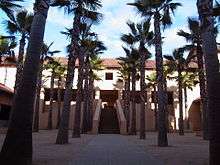Stanford Graduate School of Business
The Stanford Graduate School of Business (also known as Stanford GSB or the GSB) is the graduate business school of Stanford University in Stanford, California.
 | |
| Type | Private |
|---|---|
| Established | 1925 |
| Dean | Jonathan Levin (since 2016)[1] |
Academic staff | 114[2] |
| Postgraduates | 816 MBAs, 83 MS[1] |
| 101 PhDs in residence[1] | |
Other students | 2,284 (Executive education)[1] |
| Location | , , United States |
| Campus | Suburban |
| Nickname | Stanford GSB |
| Affiliations | Stanford University |
| Website | gsb |
Stanford GSB offers a general management Master of Business Administration (MBA) degree, the MSx Program (MS in Management for mid-career executives) and a PhD program, along with joint degrees with other schools at Stanford including Earth Sciences, Education, Engineering, Law and Medicine. The GSB also offers Stanford LEAD, an online professional certificate program.
History
The school was founded in 1925 when trustee Herbert Hoover formed a committee consisting of Wallace Alexander, George Rolph, Paul Shoup, Thomas Gregory, and Milton Esberg to secure the needed funds for the school's founding.[3] Willard Hotchkiss became the first dean of Stanford GSB.
The library was formally inaugurated on April 3, 1933. The collection was established with 1,000 volumes and assorted reports.[4] The school moved from Jordan Hall to new quarters in the History Corner of the Main Quad in 1937.[5]
Jonathan Levin was appointed as the 10th dean of the school in September 2016.[6]
Campus

The Knight Management Center is situated within the greater Stanford campus. There are ten buildings at the Knight Management Center: the Gunn Building, Zambrano Hall, North Building, Arbuckle Dining Pavilion, Bass Center, the Faculty Buildings (comprising East and West buildings), the Patterson Building, the MBA Class of 1968 Building, and the McClelland Building.
The Schwab Residential Center was designed by Mexican architect Ricardo Legorreta. The 158,000 square-foot facility consists of 280 guest rooms.
There are three main art installations on campus, including Monument to Change as it Changes, Monument to the Unknown Variables, and Ways to Change.[7]
Stanford GSB maintains very close links with the venture capital, finance and technology firms of nearby Silicon Valley.[8]
Degree programs
Stanford GSB has the traditional MBA program and the MSx program:[9][10]
| Stanford MBA Program | Stanford MSx Program |
|---|---|
| Full-time, 21-month program | Full-time, 12-month program |
| 6 academic quarters | 4 academic quarters |
| 416 students per class | 80 Sloan Fellows (mid-career managers/execs) |
| 40% foreign students | 60% foreign students |
| 40% women | 25% women |
| 20% ethnic minorities | |
| Work experience: 4-year average | Work experience: 12.7-year average, 8-year minimum |
| Awards MBA degree | Awards MS in Management degree |
Full-time MBA program
The school has approximately 400 students per year in its full-time two-year MBA program, which is considered among the best in the world. In June 2006, the School announced a dramatic change to its curriculum model ("The Personalized MBA Education"). It aims to offer each student a highly customized experience by offering broader menus of course topics. The graduating class of 2009 was the first class having gone through the new curriculum.
Current and past students include Fulbright Scholars, Marshall Scholars, Coro, Gardner, Soros, Rhodes, Rotary, and Truman fellows. Approximately 15% of the class entered the MBA program with other graduate or professional degrees; including medical doctors, lawyers, and PhDs. Stanford GSB also offers a PhD in Management degree for those looking to pursue a career in academia.
The students at the school have traditionally maintained a policy of grade non-disclosure whereby they do not release grades. Some annual academic distinctions do exist. Students graduating in the top ten percent of the class are designated "Arjay Miller Scholars", named after the former dean, Arjay Miller (1969–79). The top student receives the Henry Ford II award at graduation. At the end of the first year, five students are also designated Siebel Scholars based on a combination of academics and extracurriculars.
Full-time MSx program
The Stanford MSx Program[11] is a full-time, one-year master's degree program for managers in mid-career. Fellows who successfully complete the academic program are awarded the degree of Master of Science in Management. The program's principal objective is to help participants strengthen their capacity for organizational leadership. The ideal MSx candidate is a senior manager who has had or will soon be appointed to his or her first general management position.
The Stanford MSx was previously called the Stanford Sloan Master's Program, because students in the program are known as Stanford Sloan Fellows. The Stanford MSx is one of the three Sloan Fellows programs, sharing a similar format with the others at the MIT Sloan School of Management and the London Business School. These programs were initially supported by Alfred P. Sloan, Chairman of General Motors from 1937 to 1956, who envisioned the Sloan Fellowship in his alma mater of MIT in 1931.
The degree distinguishes itself from the MBA by acknowledging the life experiences of fellows. Like the MBA program, the MSx program requires a set of core courses along with electives (normally mixed with MBAs), however, the MSx program has separate core courses, more tailored for the experience level of fellows.
Academic partnerships
Stanford GSB has a number of relationships with other leading business schools. It offers a number of Executive Education programs jointly with Harvard Business School. It also offers one of the three Sloan Fellows programs, coordinating with the others at the MIT Sloan School of Management and the London Business School.[12]
Certificate programs
Stanford LEAD Professional Certificate
The Stanford LEAD program (“LEAD” stands for learn, engage, accelerate, and disrupt)[13] is a one-year online business program in the Graduate School of Business offering access to curricular materials and students specialize personal leadership. The teaching components are coordinated 100% online although there are periodic meet-ups hosted at Stanford each year through the me2we program.[14] The annual me2we conferences have grown to become quite large, and the program's 1,800 LEAD alumni can join remotely.[15]
Stanford LEAD offers a professional certificate from the GSB’s executive education division. Admission does not require any particular educational background and is based on the candidate's work experience, recorded video statements, and a letter of recommendation.[16] The GMAT is not required.
To deliver content, LEAD uses multiple online platforms: a "virtual campus" for online collaboration with a virtual campus and video game vibe (similar to SecondLife); lessons and interactions are combined with videos, quizzes, gamification and distance collaboration tools with best-of-class products provided by Facebook, Zoom, Google, Microsoft, Virbela and NovoEd. In March 2020, Stanford GSB needed to take all on-campus graduate courses online for Coronavirus and to do so, it adopted the LEAD experience and converted 125 GSB classes to online within 72 hours.[17]
Faculty and research
The school works at the forefront of global business research and teaching. There are three winners of the Nobel Memorial Prize in Economic Sciences on the faculty (William F. Sharpe 1990, Myron Scholes 1997, Michael Spence 2001), five recipients of the John Bates Clark Award, 19 members of the American Academy of Arts and Sciences, and four members of the National Academy of Sciences.[18]
William F. Sharpe's research interests focus on macro-investment analysis, equilibrium in capital markets and the provision of income in retirement.[19] Myron Scholes’ research has focused on understanding uncertainty and its effect on asset prices and the value of options, including flexibility options.[20] Michael Spence's research interests focus on the study of economic growth and development, dynamic competition and the economics of information.[21]
Rankings
| Business school rankings | |
|---|---|
| Worldwide overall | |
| QS[22] | 1 |
| Times Higher Education[23] | 2 |
| U.S. News & World Report[24] | 4 |
| Worldwide MBA | |
| Business Insider[25] | 4 |
| Economist[26] | 5 |
| Financial Times[27] | 3 |
| U.S. MBA | |
| Bloomberg Businessweek[28] | 1 |
| Forbes[29] | 2 |
| U.S. News & World Report[30] | 1 |
| Vault[31] | 1 |
In recent rankings, GSB was ranked 1st by U.S. News & World Report,[32] No. 2 by Forbes, 3rd by the Financial Times, 5th by The Economist, and 1st by Bloomberg Businessweek.[33] In the ranking aggregator Poets & Quants Stanford's MBA Program was ranked 2nd in the US.[34] The Financial Times Rankings 2019 gave Stanford Graduate School of Business the fourth place in Customised Executive Education. With transparent methodology these rankings help to explore the range, content and quality of options.[35]
The Stanford Graduate School of Business is the most selective business school in the United States.[36] It has maintained the highest ratio of "applicants to available seats" of any business school in the U.S. for the last decade. It has also had the lowest acceptance rates (typically <7%) of any business school. For the Class of 2018 which entered in 2016, 6% of applicants were offered admission, and the average GMAT score of 737 and average GPA of 3.73[37] are the highest of any business school in the United States.
Donations

In August 2006, the school announced what was then the largest gift ever to a business school—$105 million from Stanford alumnus Phil Knight, MBA '62, co-founder and chairman of Nike, Inc.[38] The gift went toward construction of a $375 million campus, called the Knight Management Center, for the business school. Construction was completed in 2011. The business school comprises the Knight Management Center, the Schwab Residential Center (named after alumnus Charles R. Schwab, founder and chairman of the Charles Schwab Corporation), and Highland Hall.
Alumni
There are 26,309 living alumni, including 17,803 alumni of the MBA program. Stanford Graduate School of Business is renowned to have produced a remarkable number of successful business leaders and entrepreneurs, many among the world's wealthiest, from its alumni base.
See also
- List of business schools in the United States
- List of United States business school rankings
References
- As of September 1, 2016
- "Stanford Graduate School of Business: School Profile". Stanford University. Retrieved March 12, 2014.
- Stanford University 1916–1941, pg 79–80. J. Pearce Mitchell, 1958
- Stanford GSB History of the library gsb.stanford.edu
- Stanford GSB Our History gsb.stanford.edu
- SGSB Press Release. May 23, 2016 Jonathan Levin Named Dean of Stanford Graduate School of Business
- "Stanford GSB Artwork | Stanford Graduate School of Business". Gsb.stanford.edu. Retrieved July 19, 2016.
- Lawton-Smith, Helen (August 30, 2006). Universities, Innovation and the Economy. Taylor & Francis. ISBN 9780203358054 – via Google Books.
- "Stanford MSx". Retrieved January 6, 2013.
- "Stanford MSX Class of 2018 Profile". Retrieved December 25, 2017.
- Stanford Graduate School of Business. "Stanford MSx Program". Stanford University. Retrieved August 9, 2012.
- Bradshaw, Della (March 19, 2012). "A degree of choice for the older and wiser student". FT.com. Retrieved July 19, 2016.
- Stanford Graduate School of Business. "Stanford LEAD Program". Retrieved March 9, 2020.
- Stanford Graduate School of Business. "Stanford LEAD me2we". Retrieved March 9, 2020.
- Stanford Graduate School of Business. "In a Quick Pivot, Stanford LEAD's Annual Event Moved from On-Campus to Online". Retrieved March 30, 2020.
- Stanford Graduate School of Business. "Stanford LEAD admissions". Retrieved March 9, 2020.
- Poets & Quants. "HomeBusiness School NewsStanford's Pandemic Playbook: How The Scramble Online Is Working For MBAs Stanford's Pandemic Playbook: How The Scramble Online Is Working For MBAs". Retrieved March 31, 2020.
- Stanford GSB School profile gsb.stanford.edu
- Research statement of William F. Sharpe gsb.stanford.edu
- Research statement of Myron Scholes gsb.stanford.edu
- Research statement of Michael Spence gsb.stanford.edu
- "QS Global MBA Rankings 2020". Quacquarelli Symonds. Retrieved September 26, 2019.
- "World University Rankings 2019 by subject: business and economics". Times Higher Education. Retrieved September 25, 2019.
- "Best Global Universities for Economics and Business". U.S. News & World Report. 2019. Retrieved September 25, 2019.
- "The 50 best business schools in the world 2015". Business Insider. Retrieved September 25, 2019.
- "Full time MBA ranking". The Economist. 2019. Retrieved January 27, 2020.
- "Global MBA Ranking 2020". Financial Times. Retrieved January 27, 2020.
- "Best B-Schools". Bloomberg Businessweek. November 8, 2018. Retrieved September 25, 2019.
- "The Best Business Schools". Forbes. 2019. Retrieved September 25, 2019.
- "2019 Best Business Schools Rankings". U.S. News & World Report. Retrieved September 25, 2019.
- "Best Business Schools". Vault.com. 2017. Retrieved September 25, 2019.
- "Best Business Schools". U.S. News & World Report.
- "Terms of Service Violation". Bloomberg Businessweek.
- "Poets and Quants 2015 MBA Rankings". November 18, 2015.
- http://rankings.ft.com/businessschoolrankings/executive-education-customised-2019
- Zlomek, Erin. (2013-04-18) India's IIM-A, the World's Toughest B-School to Get Into. Businessweek. Retrieved on 2013-08-12.
- "Stanford GSB Entering Class Profile". Retrieved November 24, 2016.
- "Nike Founder Phil Knight to Give $105 Million to Stanford GSB".
External links
| Wikimedia Commons has media related to Stanford Graduate School of Business. |